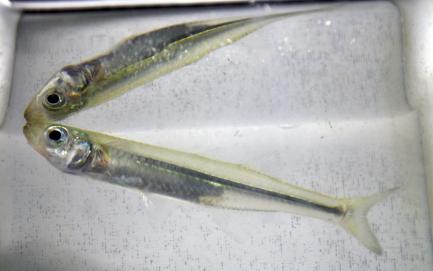A reflected inland silverside (Menidia beryllina) performs “aquatic surface respiration” in an aquarium. When threatened with low oxygen, fish often swim to the surface, where oxygen is more abundant but predators can more easily spot them.
Acidification and Low Oxygen Put Fish in Double Jeopardy
Severe oxygen drops in the water can leave trails of fish kills in their wakes, but scientists thought adult fish would be more resilient to the second major threat in coastal waters: acidification. A new study published Tuesday from the Smithsonian Environmental Research Center (SERC) shows that is not entirely true—where fish are concerned, acidification can make low oxygen even more deadly.
Low oxygen and high acidity almost always go hand in hand. In coastal waters, nutrient pollution fuels the growth of algae and other organisms. As microbes, plants and animals take up oxygen through respiration, oxygen levels plummet to low levels or even zero. At the same time, acidity spikes as those same organisms release carbon dioxide. Worldwide, both low oxygen and acidity are expected to worsen as ocean temperatures rise. But until now, most research on how well fish cope has focused on either oxygen or acidification alone. This new study shows the consequences of the double threat: Fish exposed to low oxygen and high acidity can die at higher oxygen levels, suggesting the low-oxygen thresholds considered “safe” might not be as safe as once thought.
“Those dissolved oxygen limits actually might not be as protective as we thought they were,” said Seth Miller, postdoctoral fellow and lead author of the study published in Marine Ecology Progress Series.
Even more surprising was the discovery that acidity hurt adult fish. While past research had uncovered dangers for juvenile fish and larvae, adults were thought to be more resilient to increases in acidity by virtue of the fact that their growth has slowed and they have stopped developing.
The team looked at two species of adult silversides, the Atlantic silverside and the inland silverside. Silversides are one of the most abundant fish in estuaries along the Atlantic Coast of the United States, Miller said, so what happens to them can reverberate throughout the entire food web.
Silversides and many other fish have two main behaviors to deal with low oxygen. They swim to the surface, where oxygen levels are often higher, and they beat the flaps over their gills (opercula) more quickly, to increase water flow and oxygen supply. Miller, co-author Denise Breitburg and their collaborators wanted to find out if adding acidity to low oxygen would force silversides to start using these coping mechanisms, and ultimately die, at higher oxygen levels.
The researchers put groups of three silversides each into tanks in a wet lab at SERC’s campus in Edgewater, Md. They exposed each fish trio to one of four scenarios: lowering oxygen alone, lowering pH alone (raising acidity), lowering oxygen and pH simultaneously, or a control in which nothing changed. Then they watched for when the fish first came to the surface to find more oxygen, when they came to the surface and stayed, and when all three silversides died. In a second experiment, they recorded how quickly fish beat their gill flaps. For that, they needed selfie sticks.
“We initially tried to look at the fish and count their beats, which, one, is nearly impossible to do and, two, freaks the fish out,” Miller explained. On the other hand, “they were totally uninterested in the camera on a selfie stick.”
The team discovered acidification made fish more vulnerable to the dangers of low oxygen. When they lowered oxygen and pH together, both species began swimming to the surface at oxygen levels 25 to 60 percent higher than when the team lowered only oxygen. They also beat their gill flaps more slowly, a tactic that might protect them from acidification but makes them less able to handle sharp oxygen drops. They died sooner as well. Silversides died at oxygen levels between 10 and 54 percent higher when facing acidification and low oxygen combined than facing low oxygen alone.
But death by low oxygen is not the only danger posed by acidification. When fish swim to the surface, they also become more vulnerable to predators like birds. And when oxygen drops to the point where fish lose their equilibrium and can no longer swim straight, they lose their ability to escape or hide. “If a fish is out in the wild and loses its equilibrium, that fish is dead,” Miller said.
Two major changes could help better protect fish and the creatures that depend on them, Breitburg said. First, it is critical to cut nutrient pollution and carbon emissions, since both can exacerbate low oxygen and acidification in coastal waters. Second, regulators need to treat acidification and low oxygen as linked problems, because they are so often linked in nature.
“When we look at combinations of these stressors, sometimes we find effects that are much worse than when we look at them one at a time,” she said. “And importantly, we’re often surprised at the consequences.”
The study will be available after publication at http://dx.doi.org/10.3354/meps11695. For images, an advance copy of the paper or to speak to the authors, contact Kristen Minogue at 443-482-2325 or minoguek@si.edu.
# # #
SI-201-2016
Kristen Goodhue
443-482-2325




